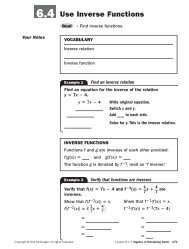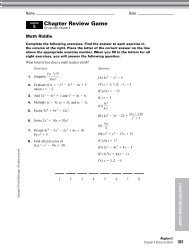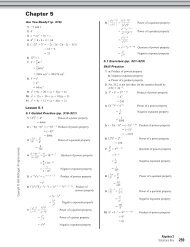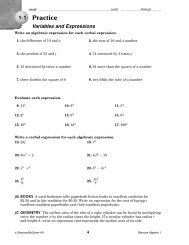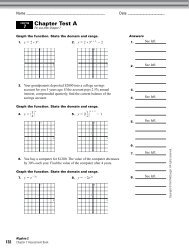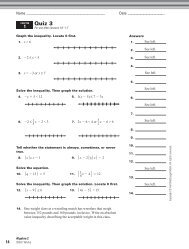Study Guide and Intervention (continued) - MathnMind
Study Guide and Intervention (continued) - MathnMind
Study Guide and Intervention (continued) - MathnMind
You also want an ePaper? Increase the reach of your titles
YUMPU automatically turns print PDFs into web optimized ePapers that Google loves.
9-1<br />
NAME ______________________________________________ DATE ____________ PERIOD _____<br />
<strong>Study</strong> <strong>Guide</strong> <strong>and</strong> <strong>Intervention</strong><br />
Factors <strong>and</strong> Greatest Common Factors<br />
Prime Factorization When two or more numbers are multiplied, each number is called<br />
a factor of the product.<br />
Prime Number<br />
Composite Number<br />
Prime Factorization<br />
Definition Example<br />
A prime number is a whole number, greater than 1, whose only factors are<br />
1 <strong>and</strong> itself.<br />
A composite number is a whole number, greater than 1, that has more than<br />
two factors.<br />
Prime factorization occurs when a whole number is expressed as a product<br />
of factors that are all prime numbers.<br />
Example 1 Example 2<br />
Factor each number.<br />
Then classify each number as prime or<br />
composite.<br />
a. 28<br />
To find the factors of 28, list all pairs of<br />
whole numbers whose product is 28.<br />
1 28 2 14 4 7<br />
Therefore, the factors of 28 are 1, 2, 4, 7,<br />
14, <strong>and</strong> 28. Since 28 has more than 2<br />
factors, it is a composite number.<br />
b. 31<br />
To find the factors of 31, list all pairs of<br />
whole numbers whose product is 31.<br />
1 31<br />
Therefore, the factors of 31 are 1 <strong>and</strong> 31.<br />
Since the only factors of 31 are itself <strong>and</strong><br />
1, it is a prime number.<br />
Exercises<br />
© Glencoe/McGraw-Hill 523 Glencoe Algebra 1<br />
5<br />
10<br />
45 3 2 5<br />
Find the prime<br />
factorization of 200.<br />
Method 1<br />
200 2 100<br />
2 2 50<br />
2 2 2 25<br />
2 2 2 5 5<br />
All the factors in the last row are prime, so<br />
the prime factorization of 200 is 23 52 .<br />
Method 2<br />
Use a factor tree. 200<br />
2 100<br />
2 10 10<br />
2 2 5 2 5<br />
All of the factors in each last branch of the<br />
factor tree are prime, so the prime<br />
factorization of 200 is 2 3 5 2 .<br />
Find the factors of each number. Then classify the number as prime or composite.<br />
1. 41 2. 121<br />
3. 90 4. 2865<br />
Find the prime factorization of each integer.<br />
5. 600 6. 175 7. 150<br />
Factor each monomial completely.<br />
8. 32x 2 9. 18m 2 n 10. 49a 3 b 2<br />
Lesson 9-1



